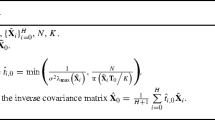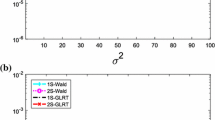Abstract
This paper studied the problem of adaptive detection of distributed targets in colored noise with unknown covariance matrix (CM), for the case where limited noise-only (training) data are available to estimate this CM. We first filter the test and training data with the normalized conjugate signal steering vector which is matched to the target signal, to preserve the signal power while suppressing the noise power; second, we derive the generalized likelihood ratio test. The new detector has the desired constant false alarm rate feature against the noise CM; it needs less training data, has a lower computational complexity and performs better (more robust) for matched (mismatched) signals, when compared with its natural counterparts.





Similar content being viewed by others
Notes
The one-step (OS) design strategy means that all the unknown parameters are replaced by their estimates within one step.
The test data are sampled from the cells under test (CUTs); they contain only Gaussian noise under the null hypothesis, and they contain Gaussian noise plus useful signal under the alternative hypothesis.
The training data are sampled from the cells adjacent to the CUTs; they contain only independent and identically distributed Gaussian noise. The training data are mainly used to estimate the noise covariance matrix (NCM) of the test data.
The homogeneous environment means that the test and training data have the same NCM.
The two-step (TS) design strategy contains two steps: First, the NCM is assumed to be known and the test statistic is derived; then, the NCM is replaced by its estimate which involves the training data alone.
This selective means that a detector is sensitive to the mismatched signals.
The quasi-whitening subspace means that the subspace is not whitened by the actual NCM but by the estimate of the NCM. This estimate is calculated from the training data alone.
References
T.W. Anderson, An Introduction to Multivariate Statistical Analysis (Wiley, New York, 2003)
F. Bandiera, O. Besson, G. Ricci, An ABORT-like detector with improved mismatched signals rejection capabilities. IEEE Trans. Signal Process. 56(1), 14–25 (2008)
L. Cai, H. Wang, A persymmetric multiband GLR algorithm. IEEE Trans. Aerosp. Electron. Syst. 28(3), 806–816 (1992)
V. Carotenuto, A. De Maio, D. Orlando, L. Pallotta, Adaptive radar detection using two sets of training data. IEEE Trans. Signal Process. 66(7), 1791–1801 (2018)
E. Conte, A. De Maio, G. Ricci, GLRT-based adaptive detection algorithms for range-spread targets. IEEE Trans. Signal Process. 49(7), 1336–1348 (2001)
G. Cui, L. Kong, X. Yang, GLRT-based detection algorithm for polarimetric MIMO radar against SIRV clutter. Circuits Syst. Signal Process. 31(3), 1033–1048 (2012)
G. Cui, L. Kong, X. Yang, J. Yang, The Rao and Wald tests designed for distributed targets with polarization MIMO radar in compound-Gaussian clutter. Circuits Syst. Signal Process. 31(1), 237–254 (2012)
A. De Maio, A new derivation of the adaptive matched filter. IEEE Signal Process. Lett. 11(10), 792–793 (2004)
A. De Maio, Rao test for adaptive detection in Gaussian interference with unknown covariance matrix. IEEE Trans. Signal Process. 55(7), 3577–3584 (2007)
A. De Maio, G. Ricci, A polarimetric adaptive matched filter. Signal Process. 81(12), 2583–2589 (2001)
A. De Maio, D. Orlando, C. Hao, G. Foglia, Adaptive detection of point-like targets in spectrally symmetric interference. IEEE Trans. Signal Process. 64(12), 3207–3220 (2016)
A. De Maio, D. Orlando, I. Soloveychik, A. Wiesel, Invariance theory for adaptive detection in interference with group symmetric covariance matrix. IEEE Trans. Signal Process. 64(23), 6299–6312 (2016)
G. Foglia, C.P. Hao, A. Farina, G. Giunta, D. Orlando, C.H. Hou, Adaptive detection of point-like targets in partially homogeneous clutter with symmetric spectrum. IEEE Trans. Aerosp. Electron. Syst. 53(4), 2110–2119 (2017)
C. Hao, J. Yang, X. Ma, C. Hou, D. Orlando, Adaptive detection of distributed targets with orthogonal rejection. IET Radar Sonar Navig. 6(6), 483–493 (2012)
C. Hao, D. Orlando, G. Foglia, X. Ma, S. Yan, C. Hou, Persymmetric adaptive detection of distributed targets in partially-homogeneous environment. Digit. Signal Process. 24, 42–51 (2014)
E.J. Kelly, An adaptive detection algorithm. IEEE Trans. Aerosp. Electron. Syst. 22(1), 115–127 (1986)
H. Li, Y. Jiang, J. Fang, M. Rangaswamy, Adaptive subspace signal detection with uncertain partial prior knowledge. IEEE Trans. Signal Process. 65(16), 4394–4405 (2017)
H. Li, H. Wang, H. Han, H. Dai, W. Liu, Performance analysis of adaptive detectors for a distributed target based on subspace model. Circuits Syst. Signal Process. 37(6), 2651–2664 (2018)
W. Liu, W. Xie, J. Liu, Y.L. Wang, Adaptive double subspace signal detection in Gaussian background—part I: homogeneous environments. IEEE Trans. Signal Process. 62(9), 2345–2357 (2014)
W. Liu, J. Liu, L. Huang, Z. Yang, Y.L. Wang, Distributed target detectors with capabilities of mismatched subspace signal rejection. IEEE Trans. Aerosp. Electron. Syst. 53(2), 888–900 (2017)
J. Liu, S. Liu, W. Liu, S. Zhou, S. Zhu, Z. Zhang, Persymmetric adaptive detection of distributed targets in compound-Gaussian sea clutter with Gamma texture. Signal Process. 152, 340–349 (2018)
W. Liu, J. Liu, L. Huang, Q. Du, Y.L. Wang, Performance analysis of reduced-dimension subspace signal filtering and detection in sample-starved environment. J. Frankl. Inst. 356, 629–653 (2019)
J. Liu, W. Liu, B. Tang, J. Zheng, S. Xu, Distributed target detection exploiting persymmetry in Gaussian clutter. IEEE Trans. Signal Process. 67(4), 1022–1033 (2019)
J. Liu, D. Orlando, P. Addabbo, W.J. Liu, SINR distribution for the persymmetric SMI beamformer with steering vector mismatches. IEEE Trans. Signal Process. 67(5), 1382–1392 (2019)
A.H. Sayed, Fundamentals of Adaptive Filtering (Wiley, New York, 2003)
L.L. Scharf, Statistical Signal Processing: Detection Estimation and Time Series Analysis (Addison, Boston, 1991)
X. Shuai, L. Kong, J. Yang, Adaptive detection for distributed targets in Gaussian noise with Rao and Wald tests. Sci. China: Inf. Sci. 55(6), 1290–1300 (2012)
G. Sun, Z. He, Y. Zhang, Distributed airborne MIMO radar detection in compound-Gaussian clutter without training data. Circuits Syst. Signal Process. 37(10), 4617–4636 (2018)
H. Van Trees, Detection, Estimation and Modulation Theory, Part I (Wiley, New York, 2001)
H. Wang, L. Cai, On adaptive multiband signal detection with GLR algorithm. IEEE Trans. Aerosp. Electron. Syst. 27(2), 225–233 (1991)
Z. Wang, M. Li, H. Chen, Y. Lu, R. Cao, P. Zhang, L. Zuo, Y. Wu, Persymmetric detectors of distributed targets in partially homogeneous disturbance. Signal Process. 128, 382–388 (2016)
Z. Wang, Z. Zhao, C. Ren, Z. Nie, W. Yang, Adaptive detection of point-like targets based on a reduced-dimensional data model. Signal Process. 158, 36–47 (2019)
S. Xu, P. Shui, X. Yan, Y. Cao, Combined adaptive normalized matched filter detection of moving target in sea clutter. Circuits Syst. Signal Process. 36(6), 2360–2383 (2017)
Y. Zhou, H. Yang, N. Li, G. Cui, L. Kong, Adaptive detection of distributed targets in Gaussian clutter based on multiple a priori spectral models. Circuits Syst. Signal Process. 36(1), 420–434 (2017)
Author information
Authors and Affiliations
Corresponding author
Additional information
Publisher's Note
Springer Nature remains neutral with regard to jurisdictional claims in published maps and institutional affiliations.
Rights and permissions
About this article
Cite this article
Wang, Z. Distributed Target Detection Using Samples Filtered with Normalized Conjugate Signal Steering Vector. Circuits Syst Signal Process 39, 4762–4774 (2020). https://doi.org/10.1007/s00034-020-01389-8
Received:
Revised:
Accepted:
Published:
Issue Date:
DOI: https://doi.org/10.1007/s00034-020-01389-8




